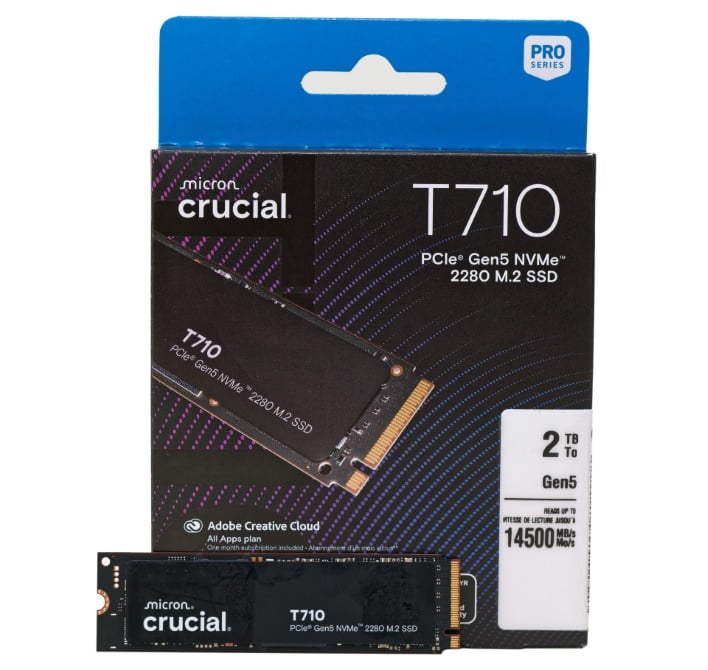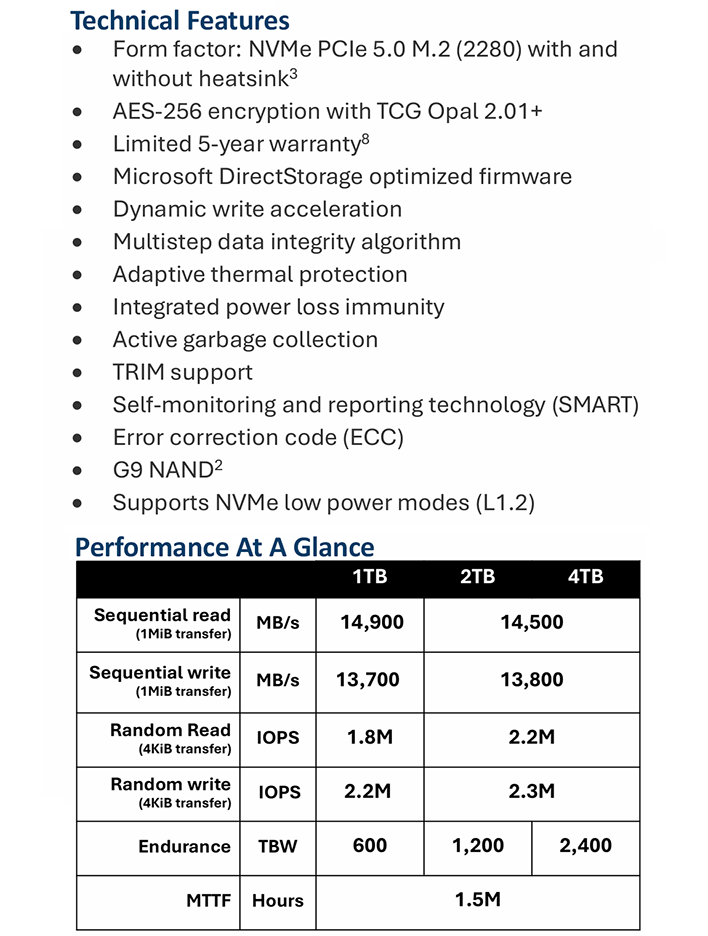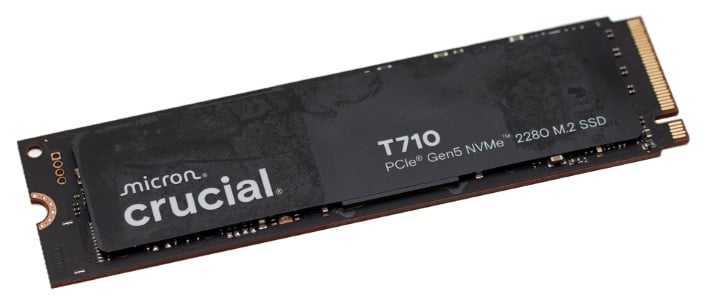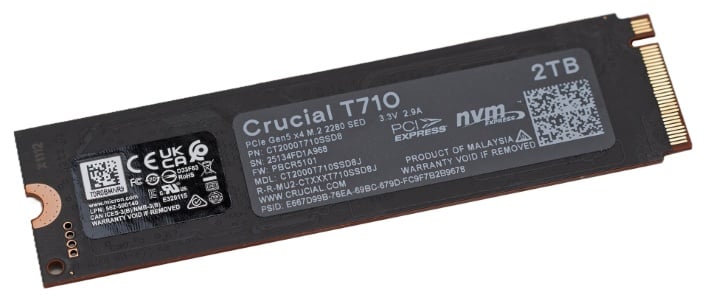Crucial T710 SSD Review: A Low-Power PCIe Gen 5 Speed Demon
|
Crucial T710 SSD - MSRP Starting @ $179 (1TB), $279 (2TB) |
|||

|

|
||
This means the Crucial T710 can be used in desktops, laptops, and game consoles, whereas most other high-performance, enthusiast-class Gen 5 drives cannot. But, we’re getting a bit ahead of ourselves. Take a look at the Crucial T710’s main features and specifications first, then we’ll get some particulars out of the way, and ultimately see how the drive performs. Let’s get to it…
Crucial T710 SSD Specifications And Features
We’ve got a 2TB drive without heatsink on hand for testing here, which is what you see in all of the pictures features here. The Crucial T710s being sold with or without heatsink are identical underneath it all. Micron is simply offering the Crucial T710 in multiple flavors to account for the widest breadth of system configurations. If your motherboard’s got built-in cooling hardware for its M.2 slots, there’s no need to buy an SSD with an included heatsink. If not, the one with the heatsink is the way to go, to ensure minimal throttling and the most consistent performance.
Some sort of cooling is recommended for these drives, however. The non-heatsink model will operate without added cooling, but under sustained loads, it will heat up and potentially throttle.
The Crucial T710 looks just like virtually all of the enthusiast-class M.2 SSDs currently on the market. The drives use the common M.2 2280 form factor and feature dark-colored PCBs with the top side of the board populated with an array of components (at least on the 2TB model we evaluated). The bottom side of the PCB is bare, save for a sticker with some branding, certifications, and technical details.
The foundation of the Crucial T710 is Silicon Motion’s SM2508 controller. The SM2508 is an 8-channel controller capable of speeds up to 3,600 MT/s per channel, manufactured on TSMC’s 6nm process technology. It features a quad-core ARM Cortex R8 CPU complex, with four PCIe lanes of connectivity, capable of 32Gb/s data transfer speeds. The controller is paired to Micron’s G9 NAND flash memory, operating at 3,600 MT/s, in addition to few pieces of DRAM cache (1GB per 1TB of capacity), and customized Micron/Crucial firmware optimized for DirectStorage and gaming.
Other features of the Crucial T710 drives include the aforementioned PCIe Gen x4 (Gen 5) interface, TRIM and active garbage collection, support for the NVMe 2.0 specification (including low power L1.2 mode), ECC, and built-in AES256 encryption with TCG Opal 2.01+ support.
Performance of the Crucial T710 will vary somewhat depending on the capacity of the drive being tested. We are looking at a 2TB drive here, which Crucial rates for up to 14,500 / 13,800MB per second reads and writes, respectively, with up to 2.2M / 2.3M read and write IOPS. Endurance for the 2TB drive we have here is rated for 1200TBW (1.2PBW), though that number scales upward or downward depending on the total capacity. Micron also backs the drives with a full, five year warranty.
The specs for the Crucial T710 look highly competitive, but all those claims don’t mean much if its actual performance doesn’t match-up, so let’s get to some benchmarks...
Crucial T710 SSD Benchmarks
Under each test condition, the SSDs featured here were installed as secondary volumes in our testbed, with a separate drive used for the OS and benchmark installations. Our testbed's motherboard was updated with the latest BIOS available at the time of publication and Windows 11 was fully updated as well. Windows Firewall, automatic updates, and screen savers were all disabled before testing, and Focus Assist was enabled to prevent any interruptions.
In all test runs, we rebooted the system, ensured all temp and prefetch data was purged, and waited several minutes for drive activity to settle and for the system to reach an idle state before invoking a test. All of the drives here have also been updated to their latest firmware as of press time. Where applicable, we would also typically use any proprietary NVMe drivers available from a given manufacturer. When not available, the drives used the in-box Microsoft NVMe driver included with Windows 11 (all of the drives tested in this article used the in-box Windows driver).HotHardware's Test System:
| Processor: Intel Core i9-14900K Motherboard: MSI Z790 Godlike Video Card: Intel iGPU Memory: 32GB Micron DDR5-6000 Storage: Samsung SSD 990 Pro (2TB) (OS Drive) ADATA Legend 970 Pro (2TB) Samsung SSD 9100 Pro (4TB) - Full Power Mode MSI Spatium M580 Frozr(2TB) Crucial T705 (2TB) Micron 4600 (2TB) Crucial T710 (2TB) |
OS: Windows 11 Pro x64 Chipset Drivers: Intel v10.1.19284 Benchmarks: IOMeter 1.1 HD Tune v6.1 ATTO v4.01.01f Blackmagic Disk Speed Test SiSoftware SANDRA CrystalDiskMark v8.0.6 x64 Final Fantasy XIV: Dawntrail PCMark 10 Storage Bench 3DMark Storage Tests |
IOMeter Benchmarks
IOMeter is a well-respected industry standard benchmark. It is debatable, however, as to whether or not certain access patterns actually provide a valid example of real-world performance. The access patterns we tested may not reflect your particular workloads, for example, or mirror the behavior of actual applications. That said, we do think IOMeter is a reliable gauge for relative throughput, latency, and bandwidth with a given storage solution. In addition, there are certain highly-strenuous workloads you can place on a drive with IOMeter that you can't with most other storage benchmark tools. In the following tables, we're showing two sets of access patterns; a custom Workstation access pattern, with an 8K transfer size, consisting of 80% reads (20% writes) and 80% random (20% sequential) access and a 4K access pattern with a 4K transfer size, comprised of 67% reads (33% writes) and 100% random access. Queue depths from 1 to 16 were tested...






Latency was competitive with the Crucial T710. It's right there in the mix with the rest of the drives we tested, which consist of some of the best high-end consumer SSDs currently available.
SiSoft SANDRA 2023

ATTO Disk Benchmark
ATTO is another "quick and dirty" type of disk benchmark that measures transfer speeds across a specific volume length. It measures raw transfer rates for both reads and writes and graphs them out in an easily interpreted chart. We chose .5KB through 64MB transfer sizes and a queue depth of 6 over a total max volume length of 256MB. ATTO's workloads are sequential in nature and measure raw bandwidth, rather than I/O response time, access latency, etc.


The Crucial T710 put up some excellent sequential reads and writes in the ATTO Disk Benchmark. Write throughout was right there in the mix with the fastest drives we tested and read throughput was also very good and led the pack with transfer sizes ranging from about 64K - 512MB. But even where it didn't lead, the Crucial T710 was among the fastest of the group anyway.


Read and write IO throughput was a mixed bag. The Crucial T710 was competitive with the other drives throughout most of the testing, but dropped down a few rungs with the smallest transfer sizes in the read test.
Blackmagic Disk Speed Test Benchmark
Next up we the DIsk Speed Test from Blackmagic Design. The Blackmagic Disk Speed Test is a simple tool to quickly measure and certify disk performance for working with high quality video files. The benchmark can be configured with various file sizes, from 1GB to 5GB. We tested with the largest 5GB file size and allowed the benchmark to loop for 3 minutes before recording the results.













